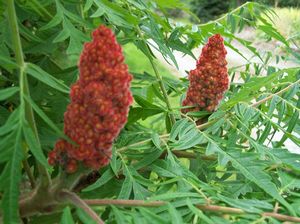View All Plants :: View All DECIDUOUS SHRUBS
Rhus typhina 'Dissecta'
Staghorn Sumac
Plant Type:
DECIDUOUS SHRUBSRhus typhina ‘Dissecta’ – This cut leaf form of Staghorn Sumac is ferny and soft. Each large uniform compound pinnate leaflet is deeply divided and upon close inspection intricately beautiful. The foliage changes through autumn days from golden orange to orange sometimes with an infusion of red before dropping. A female form, it produces red candles which adorn terminal tips of stems well into winter providing food for various bird species. They stand strong with fall and winter interest. The terminal branches are reminiscent of the racks of male deer, hence, the appropriate common name, Staghorn Sumac. Each tip is a fat finger covered in felted pubescence, studded with the large warty lenticels. Late spring/early summer 4” to 8” panicles are greenish yellow, showy and flame-shaped.
I wrote this in 2005, “Upon viewing the magnificent old stand of one of the forms of cut-leaf sumac in the garden sloping away from the gazebo at Wavehill in the Bronx, many stroll from the experience enlightened. It is an all-season wonder. The dark gray stems erupt from the ground, shoot up, arching in many instances to heights several feet above our heads, then descend to the ground yards away from the originating trunks. Each of the stems then curves up branching into the wood that produces the foliage heads. The apex of the woody arc is many feet higher than the grand tufts of foliage. This amazing architecture is unique and striking in all four seasons. The bare bones in winter become the tentacles of a mythical giant sea serpent or, perhaps, a wild-looking roller coaster for the pixies when humans are not in sight! In any case the effect is fantastical, magical.” We had thought our plant was Rhus typhina var. laciniata but believe, due to an article by Allen J. Coombes, that our Staghorn Sumac selection is actually ‘Dissecta’. In either case it’s a beautiful thing! Staghorn Sumac is a colonizer. At the northern end of the range it might be better to plant in spring... we're on the fence about this. Your choice. Your responsibility. Established potted starter Staghorn Sumac via division.
Characteristics and Attributes for Rhus typhina 'Dissecta'
Season of Interest (Flowering)
- Late Spring / Early Summer
Season of Interest (Foliage)
- Spring / Summer / Autumn
Interesting Bark
- Architectonic
- Lenticels
Autumn Interest
- Fruit / Berries / Seed Heads
- Autumn Leaf Color
Nature Attraction
- Deer Resistant
Light
- Full Sun
Attributes
- Massing
- Hedgerow
- Specimen
- Natural Garden
- Accent
Growth Rate in the Garden
- Moderately Fast
Soil
- Draining
- Fertile
Origins
- Garden Origin
Propagated By
- Division
Genus Overview: Rhus
Common Name: Sumac
These are the Sumacs, colonizing shrubs which have been largely ignored by North American gardeners. It is true that Rhus has been better appreciated across the pond, as it were. It is finally dawning upon some living on this side of the Atlantic Ocean that this the Sumacs are actually very good 4-season shrubs for those who have the space to accommodate them. Fabulous leaves, large and attractive flowers, great fall color and beautiful “candles” in winter atop architectonic wood are all attractive features. Site in full to nearly full sun planted in fertile draining soil. They are colonizing and require space to spread which they will do with gusto where happy. They make fantastic colonies in fields, roadside, on embankments on the backside of old New England stone walls. Under plant them with evergreen ferns, Juniperus virginiana ‘Grey Owl’ or perhaps Microbiota decussata, the Russian Arbor-vitae for a complete design. Most are root cutting grown, some from stem cuttings.


